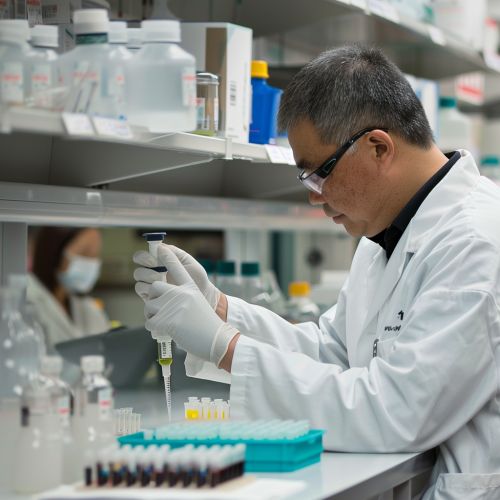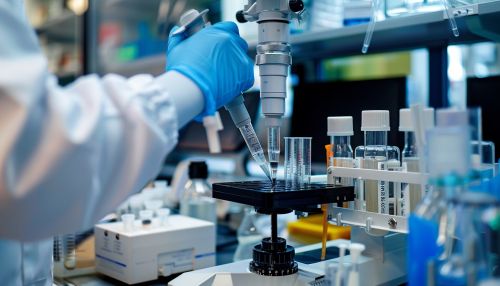Acetylation: Difference between revisions
(Created page with "== Acetylation == Acetylation is a biochemical process involving the introduction of an acetyl group (CH3CO) into a molecule. This process is critical in various biological and chemical contexts, including protein function regulation, gene expression, and metabolic pathways. Acetylation can occur on proteins, nucleic acids, and small molecules, influencing their structure, function, and interactions. <div class='only_on_desktop image-preview'><div class='image-preview-...") |
No edit summary |
||
| Line 3: | Line 3: | ||
Acetylation is a biochemical process involving the introduction of an acetyl group (CH3CO) into a molecule. This process is critical in various biological and chemical contexts, including protein function regulation, gene expression, and metabolic pathways. Acetylation can occur on proteins, nucleic acids, and small molecules, influencing their structure, function, and interactions. | Acetylation is a biochemical process involving the introduction of an acetyl group (CH3CO) into a molecule. This process is critical in various biological and chemical contexts, including protein function regulation, gene expression, and metabolic pathways. Acetylation can occur on proteins, nucleic acids, and small molecules, influencing their structure, function, and interactions. | ||
[[Image:Detail-92391.jpg|thumb|center|A laboratory setting showing a scientist performing acetylation reactions on a protein sample.|class=only_on_mobile]] | |||
[[Image:Detail-92392.jpg|thumb|center|A laboratory setting showing a scientist performing acetylation reactions on a protein sample.|class=only_on_desktop]] | |||
=== Chemical Basis of Acetylation === | === Chemical Basis of Acetylation === | ||
Latest revision as of 23:39, 14 June 2024
Acetylation
Acetylation is a biochemical process involving the introduction of an acetyl group (CH3CO) into a molecule. This process is critical in various biological and chemical contexts, including protein function regulation, gene expression, and metabolic pathways. Acetylation can occur on proteins, nucleic acids, and small molecules, influencing their structure, function, and interactions.


Chemical Basis of Acetylation
Acetylation involves the transfer of an acetyl group from acetyl-CoA to a substrate. This reaction is typically catalyzed by enzymes known as acetyltransferases. The reverse process, deacetylation, is catalyzed by deacetylases. The balance between acetylation and deacetylation is crucial for maintaining cellular homeostasis.
The acetyl group is derived from acetyl-CoA, a key molecule in metabolism. Acetyl-CoA serves as a substrate for various biochemical reactions, including the citric acid cycle and fatty acid synthesis. The acetyl group is transferred to the amino group of lysine residues in proteins or to the hydroxyl group of serine and threonine residues.
Protein Acetylation
Protein acetylation is a post-translational modification that can alter protein function, stability, and interactions. It predominantly occurs on the ε-amino group of lysine residues. This modification can affect protein activity, localization, and protein-protein interactions.
Histone Acetylation
Histone acetylation is a well-studied form of protein acetylation. Histones are proteins that package and order DNA into structural units called nucleosomes. Acetylation of histones, particularly on lysine residues, is associated with transcriptional activation. This modification reduces the positive charge on histones, decreasing their affinity for the negatively charged DNA and allowing transcription factors to access the DNA.
Histone acetylation is regulated by histone acetyltransferases (HATs) and histone deacetylases (HDACs). HATs add acetyl groups to histones, promoting gene expression, while HDACs remove acetyl groups, leading to gene repression. Dysregulation of histone acetylation is implicated in various diseases, including cancer and neurodegenerative disorders.
Non-Histone Protein Acetylation
Acetylation also occurs on non-histone proteins, affecting various cellular processes such as metabolism, cell cycle regulation, and signal transduction. Proteins such as p53, a tumor suppressor, and tubulin, a component of the cytoskeleton, are subject to acetylation. Acetylation of p53 can enhance its stability and transcriptional activity, while acetylation of tubulin affects microtubule dynamics and cell motility.
Nucleic Acid Acetylation
Acetylation can also occur on nucleic acids, particularly on RNA. RNA acetylation, such as N4-acetylcytidine (ac4C), is a modification found in tRNA and mRNA. This modification can influence RNA stability, translation efficiency, and the accuracy of protein synthesis. The enzymes responsible for RNA acetylation are known as RNA acetyltransferases.
Metabolic Acetylation
Acetylation plays a significant role in metabolism, particularly in the regulation of metabolic enzymes. Acetylation of metabolic enzymes can modulate their activity, stability, and interactions. For example, acetylation of enzymes involved in glycolysis and the tricarboxylic acid (TCA) cycle can influence cellular energy production and metabolic flux.
Acetylation in Disease
Dysregulation of acetylation is associated with various diseases, including cancer, neurodegenerative disorders, and metabolic diseases. Aberrant acetylation patterns can lead to altered gene expression, protein dysfunction, and disrupted cellular processes.
Cancer
In cancer, dysregulation of histone acetylation can lead to aberrant gene expression, promoting oncogenesis. Mutations in HATs and HDACs, as well as altered expression of these enzymes, have been observed in various cancers. Targeting acetylation pathways with inhibitors of HATs and HDACs is a therapeutic strategy being explored in cancer treatment.
Neurodegenerative Disorders
In neurodegenerative disorders such as Alzheimer's disease and Parkinson's disease, altered acetylation patterns have been observed. Histone acetylation can influence the expression of genes involved in neuronal function and survival. Additionally, acetylation of non-histone proteins, such as tau and α-synuclein, can affect their aggregation and toxicity.
Metabolic Diseases
Acetylation of metabolic enzymes is implicated in metabolic diseases such as diabetes and obesity. For example, acetylation of enzymes involved in glucose and lipid metabolism can affect their activity and regulation, contributing to metabolic dysregulation.
Techniques for Studying Acetylation
Various techniques are used to study acetylation, including mass spectrometry, Western blotting, and chromatin immunoprecipitation (ChIP). These techniques allow for the identification and quantification of acetylation sites, as well as the study of acetylation dynamics and functional consequences.
Mass Spectrometry
Mass spectrometry is a powerful tool for identifying acetylation sites on proteins. It involves the digestion of proteins into peptides, followed by the analysis of peptide masses to identify acetylated residues. This technique provides high sensitivity and specificity for detecting acetylation.
Western Blotting
Western blotting is commonly used to detect acetylation levels of specific proteins. It involves the separation of proteins by gel electrophoresis, transfer to a membrane, and detection with antibodies specific to acetylated residues. This technique allows for the quantification of acetylation levels and the study of acetylation dynamics.
Chromatin Immunoprecipitation (ChIP)
ChIP is used to study histone acetylation and its association with specific genomic regions. It involves the crosslinking of proteins to DNA, immunoprecipitation with antibodies specific to acetylated histones, and analysis of the associated DNA sequences. This technique provides insights into the role of histone acetylation in gene regulation.
Therapeutic Targeting of Acetylation
Given the importance of acetylation in various diseases, targeting acetylation pathways is a promising therapeutic strategy. Inhibitors of HATs and HDACs are being developed and tested for their efficacy in treating cancer, neurodegenerative disorders, and other diseases.
Histone Deacetylase Inhibitors (HDACi)
HDAC inhibitors (HDACi) are a class of compounds that inhibit the activity of HDACs, leading to increased histone acetylation and gene expression. HDACi have shown promise in the treatment of cancer, as they can induce cell cycle arrest, apoptosis, and differentiation in cancer cells. Several HDACi, such as vorinostat and romidepsin, have been approved for the treatment of certain cancers.
Histone Acetyltransferase Inhibitors (HATi)
HAT inhibitors (HATi) are less well-developed compared to HDACi, but they hold potential for therapeutic applications. Inhibiting HATs can reduce the acetylation of oncogenic proteins and histones, thereby suppressing tumor growth. Research is ongoing to identify and develop effective HATi for clinical use.
Conclusion
Acetylation is a critical post-translational modification that regulates various biological processes. It plays a key role in gene expression, protein function, and metabolism. Dysregulation of acetylation is associated with numerous diseases, making it a significant area of study for understanding disease mechanisms and developing therapeutic strategies. Advances in techniques for studying acetylation and the development of acetylation-targeting drugs hold promise for improving disease treatment and patient outcomes.
